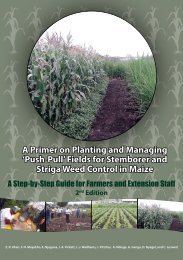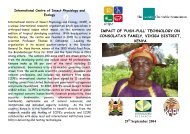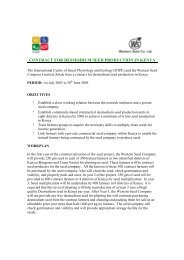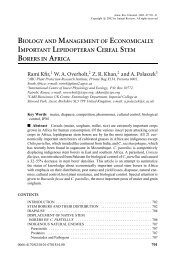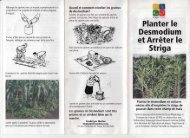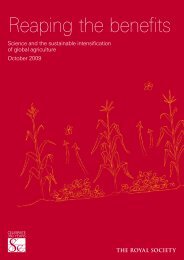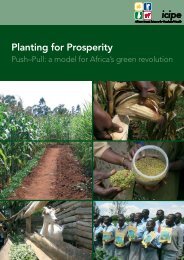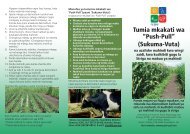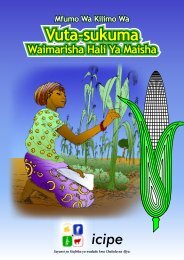Genetic engineering versus organic farming. - Push-Pull
Genetic engineering versus organic farming. - Push-Pull
Genetic engineering versus organic farming. - Push-Pull
Create successful ePaper yourself
Turn your PDF publications into a flip-book with our unique Google optimized e-Paper software.
Your questions – our answers<strong>Genetic</strong> <strong>engineering</strong> <strong>versus</strong><strong>organic</strong> <strong>farming</strong>.The fact and the fiction.From bees and carrots – 4 stories
Die Deutsche Bbliothek – CIP Cataloguing – in-Publication-DataA catalogue record for this publication is available fromDie Deutsche Bibliothek© IFOAM 2002ISBN 3-934055-16-8Price: 4 Euro
Who benefits? Who needs it? Where does it lead?These are useful questions to ask when assessinga new technology. In the case ofGMOs (genetically modified organisms) thereare no benefits for either consumers or producers– only for the companies producingand selling them.If farmers feel they need herbicide-resistantvarieties that is because they are locked intoa production system that depends on chemicalinputs.<strong>Genetic</strong> <strong>engineering</strong> is just one more stepinto a cul-de-sac (blind alley) that leads tofurther degradation of the environment,increased dependency of farmers and morerisks for everybody.The <strong>organic</strong> movement rejects GMOs in allagriculture, from an economic and ethicalperspective, from a political perspective, froma risk perspective and simply because it is notneeded.We also offer a real alternative. Millions of<strong>organic</strong> farmers, big or small, rich or poor,demonstrate daily that <strong>organic</strong> agriculturecan produce sufficient safe food for everyone– without using GMOs.Gunnar RundgrenIFOAM President
<strong>Push</strong>-and-<strong>Pull</strong>: an innovative and low-tech solution to control stemborers in AfricaThe stemborer is Africa’s worst maize pest. In combination with the Striga weed it can destroy whole crops. The International ResearchInstitute ICIPE in Kenya, together with local farmers, developed a successful <strong>Push</strong>-and-<strong>Pull</strong> strategy: The farmers plant 3 rows of the fodder grassNapier around the maize field. Napier grass has a chemical aroma that attracts the stemborer larvae out of the maize crop. Most of them arekilled in the sticky sap of the Napier grass. Between the rows of maize farmers also plant the legume Desmodium, which exudes a chemical aromathat repels stemborers. Desmodium also suppresses Striga. It is a perfect <strong>Push</strong>-and-<strong>Pull</strong> strategy, which provides healthy maize, additional feedand protection for the soil.Another approach to control the stemborer is genetically engineered Bt-maize: This maize, with genes from the soil bacterium Bt, produces atoxin to combat the stemborer. The Swiss multinational company Syngenta started a project with Bt-maize in Kenya, together with a KenyanInstitute. But is it sensible to invest everything in an unproven and risky technology, which also increases once again the dependency of smallfarmers?Left: Mrs Ouzo’s fields werecompletely destroyed by thestemborer. Now– with <strong>Push</strong>and-<strong>Pull</strong>–she has good yields.Middle: Stemborer in maize.Right: close-up of an advertisementof a biotech company:The vision is monocultures.
Vitamin A rice - a grand illusion?Vitamin A rice – a genetically engineeredrice producing pro-vitamin A – is beingoffered to the Third World as a remedyfor widespread Vitamin A Deficiency(VAD). But there are fundamental problems:An adult would need to eat 9 kg of cookedrice a day for the required intake of vitaminA (whereas eating just two carrots would beenough). It is an open question whether transgenicrice will work in practice, and nothingis known about long-term threats to ecosystemsand human health. Furthermore, thereare many patents on Vitamin A rice. "Theproblem is that the transgenic rice will notremove VAD. It is a technology that fails in itspromise, because there are no silver bulletsolutions to such complex problems", says theIndian scientist Vandana Shiva.habits is essential. Small gardens with greenleafy vegetables and with fruits, leaves fromwild plants, dried mango slices, dried Baobableaves, sweet potatoes... Even the World Bankhas admitted that rediscovering and using localplants and conserving vitamin A rich fruit andvegetables has dramatically reduced the numberof VAD threatened children in inexpensiveand efficient ways.The MAIN point is, however, that there aremany better, cheaper and already provensolutions. The root cause of VAD and manyother diseases is a totally unbalanced diet: rice,rice and nothing but rice. So changing dietaryLeft: The beauty of diversity–thebest prevention for VAD.Right: The genetically engineeredrice is also patented.
Using bees as 'Flying Doctors'Grey mould is the worst disease affectingstrawberries. A clever new <strong>organic</strong> controluses honey bees or bumble bees. When thebee leaves the hive, she passes through afootbath containing an antidote to grey mould.This is a harmless fungus. When bees pollinatethe strawberry blossoms, they deliver theharmless fungus precisely into the blossoms.The beneficial fungus thus inoculates theblossoms preventing infection by grey mould.Recent studies in the US and Switzerlandshow that strawberry yields can be more thandoubled with the help of these ‘Flying Doctors’.were asked not to use perfume because thiscould confuse the plants.) Scientists are tryingto find out if these scents could be used towarn tomatoe plants in advance of a caterpillarinvasion. The plants would be perfectly prepared:a clever strategy, using nature’s own methods.More findings from modern <strong>organic</strong>research: plants can ‘talk’ to each other.When attacked by a caterpillar, a tomatoeplant starts to produce defence chemicals.It also warns neighbouring plants by exudinga scent as an SOS-signal. These tomatoes thenalso start to produce the defence chemicals,even though they are not being attacked. (Thisscent, methyl-jasmonate, is often used inperfumes. During the experiments womenLeft: Bumble beeRight: Perfume flask: tomatoes‘talk’ to each other with scents.
<strong>Genetic</strong> contamination - a serious problemMaize comes originally from Mexico andPeru. Here the greatest diversity of maizecultivars and wild species can be found. This‘centre of origin’ with its amazing geneticdiversity is essential for the future of maizebreeding and thus for world-wide food security.But this ‘centre of origin’ is already contaminated.A US-study shows that even in remoteMexican valleys local maize varieties containgenes from transgenic Bt-maize. "We weresurprised by these results. We didnot expectany such thing, and it's most disturbing. Whatthis means is that an entire species in its nativestate may soon become, in effect, geneticallycontaminated " says scientist Ignacio Chapellafrom the University of California (USA), who'steam did this research.The Mexican study indicates that genes fromtransgenic plants can spread across geographicareas and between varieties more quickly thanscientists had previously thought.Left: Great variety of maizecultivars.Right: <strong>Genetic</strong> <strong>engineering</strong> in thelaboratory.
Your questions - our answers1.What is genetic<strong>engineering</strong> ?<strong>Genetic</strong> <strong>engineering</strong> is a new technology, involvingthe manipulation of genes. Scientists can transfergenes from one species to another, unrelatedspecies. This is possible because of the universal‘gene language’ – the genetic code. It is the samefor all living beings, be it animal, plants or microorganisms.For example, genes from a fish can betransferred to a tomatoe plant to render thetomatoe plant more resistant to frost. Theengineered tomatoe plant is genetically forcedto produce the fish chemical, because of thisuniversal ‘gene language’. So it produces an‘antifreeze’ chemical which the fish normallyproduces to survive in freezing cold water.With genetic <strong>engineering</strong> it is possible to breakdown the species boundaries set up by millionsof years of evolution. Never before was it possibleto transfer genes from animals to plants or frombacteria to humans. By combining the genes ofunrelated species, permanently altering their geneticcodes, novel organisms are created that will passthe genetic changes onto their offspring throughheredity.<strong>Genetic</strong> <strong>engineering</strong> is a corporate technology,mainly applied by industrial agriculture. In the year2000:• just five multinationals dominated the wholebiotech business in agriculture.• 98% of all transgenic crops were grown inthree countries: the USA, Canada and Argentina.• Two features were dominant: well over70% of all GM-crops grown world wide areherbicide-resistant plants, and over 20 % areinsect-resistant Bt-plants.2.What is <strong>organic</strong> <strong>farming</strong> ?Organic agriculture is a sustainable form ofproduction. It promotes and enhances biodiversity,biological cycles and soil biological activity. It isbased on minimal use of off-farm inputs and onmethods that restore, maintain and enhanceecological harmony. Organic <strong>farming</strong> does not usesynthetic chemical pesticides, herbicides andfertilisers relying instead on developing a healthy,fertile soil and sound crop rotations. In this way,the farm remains biologically balanced, with a widevariety of beneficial insects and other organismsto act as natural predators for crop pests and asoil full of micro organisms and earthworms tomaintain its vitality. If direct control measures haveto be taken to prevent serious crop damages,different agents of natural sources (for exampleNeem and Pyrethrum extracts) and biocontrolagents (for example ladybirds against aphids)can be used.Organic livestock production focuses on animalwelfare and husbandry methods that prevent theneed for veterinary treatments. It is a method ofagricultural production that is environmentallyfriendly, requiring high standards of animal welfarewith health benefits for people. Organic <strong>farming</strong>recognises that human health is directly connectedto the health of the food we eat and, ultimately,the health of the soil. Organic agriculture bothVandana Shiva, President ofthe Research Foundation forScience, Technology andEcology, India; winner of theAlternative Nobel prize 1993:"<strong>Genetic</strong>ally engineered plants arepatented. Farmers are not allowedto save or exchange seed fromtheir crops. Through patentinga thousand-year-old traditionis turned into a criminal act.This cannot work. I'm convincedthat <strong>organic</strong> <strong>farming</strong> is the onlyoption - for the South and forthe North."
elies on the vast knowledge and skills of farmersand on modern research to provide innovativenew technologies.‘Organic <strong>farming</strong>’ is a term defined by IFOAMstandards and all <strong>organic</strong> food production andprocessing is governed by a strict set of standardsand guidelines.3. Why are genetic<strong>engineering</strong> and <strong>organic</strong><strong>farming</strong> incompatible ?Organic <strong>farming</strong> and genetic <strong>engineering</strong> are twocontradictory world views, two different philosophies,the two main options for the future.The basic principles of <strong>organic</strong> <strong>farming</strong> are holistic.Rather than looking at isolated parts, the wholefarm as a living entity is the focus. It is seen as awhole, enmeshed in the intrinsic web of life andpart of the interactions and relationships betweenall living beings. Organic <strong>farming</strong> seeks to maintainan overall balance, by enhancing biodiversity (forexample, flowering plants are sown on the bordersof fields to attract beneficial insects into the crops).Organic pesticides are only used in emergenciescases, as supplementary measures.<strong>Genetic</strong> <strong>engineering</strong>, on the contrary, isolates andreduces complex problems to single issues andthen tries to find a technical solution. The verybasis of genetic <strong>engineering</strong> depends on the searchfor single-factor-solutions, whereas all majorproblems of the environment and agriculture aremulti-factoral. An example: Bt-maize expresses atoxin that kills the maize pest stemborer. But whatif other, often beneficial, insects (such as lacewings,the monarch- or the black swallowtail-butterfly)are harmed as well? What consequences followif the toxin also influences the soil-food-web orif the stemborer acquires a resistance to theBt-toxin?4. What are the differencesbetween conventionalbreeding and genetic<strong>engineering</strong> ?Proponents of genetic <strong>engineering</strong> often claimthat they are doing the same work as conventionalbreeding, just faster and with more precision.It is true that gene transfers also occur in conventionalplant breeding, but these only take placebetween individuals of the same species, or, insome cases, between closely related species. A riceplant can cross with a different rice species, butnot with a walnut. <strong>Genetic</strong> <strong>engineering</strong> is not boundby these limits. So, for example the geneticallyengineered Vitamin A rice contains newly insertedgenes from daffodils, viruses and bacteria. As aresult a new form of life has been created.5. Is genetic <strong>engineering</strong>affecting <strong>organic</strong> <strong>farming</strong> ?The standards established by IFOAM categoricallyexclude genetically engineered organisms andproducts containing GMOs from the <strong>organic</strong>production system. With the application oftransgenic organisms problems of contaminationarise at different levels:Hans Herren, Director of theICIPE , Kenya, winner of theWorld Food prize 1995:"When I'm visiting agriculturalresearch institutes in Africa andIndia, I find the labs for biologicalcontrol half empty and withbroken windows. But the biotechlabswill be all new, with newequipment and stuffed with staff.Biocontrol projects, as we do it,are not so spectacular, not so sexy.Here I see a big problem."
Regina Fuhrer, president ofthe Swiss Organic Farmersassociation:"I'm an <strong>organic</strong> farmer. For me it'sobvious that genetic <strong>engineering</strong>has to be kept out of agriculture.The risk of contamination is fartoo big. But above all we havemuch better solutions, dealingcarefully and respectfully withnature."• In the field: Pollen from genetically engineeredplants is blown by wind or carried by insectsinto other fields, thus contaminating these crops.Bees are known to distribute pollen over adistance of 3 kilometres.• In seed production: Breeding and multiplicationof <strong>organic</strong> seed and seedlings is also affectedby contamination from pollen from GM-plants.• During harvesting, transport and processing:At all points from the field to the final processingfacility (during transport on trucks, ships ortrains, in mills, in food-processing factories etc.)there are many opportunities for contamination.Only strict segregation can minimise the risk.Farmers, processors and traders wanting to produceand sell <strong>organic</strong> and GMO-free products; andconsumers wanting to buy it, are confronted withmassive problems of genetic pollution.Another problem is that the pests may developresistance to the Bt-toxin of transgenic plants. Btspraysare also used in <strong>organic</strong> <strong>farming</strong>, however,as an effective, natural insecticide. If this resistancewere to occur they would become ineffective.6. Will genetic <strong>engineering</strong>feed the hungry ?No agricultural revolution has ever solved theproblem of world hunger. Hunger is a social andpolitical problem and not a problem of productiontechniques. There is more than enough food foreverybody in the world today. <strong>Genetic</strong> <strong>engineering</strong>may actually lead to more food insecurity andhunger because it will encourage the planting ofmonocultures, highly vulnerable to disease andpests, and it will make farmers more dependenton multinational companies that will demandpayment for the patented GM-plants and seeds,and for chemicals and fertilisers. GMO-agricultureis the continuation of industrialised agriculture withall its known problems in an even more threateningdimension. Through unequal promotion of anindustrialised GMO-agriculture the naturalresources for all our food – biodiversity, healthysoils and clean water – will be further destroyed.7. Will <strong>organic</strong> <strong>farming</strong> feedthe hungry ?The main question confronting <strong>organic</strong> and sustainable<strong>farming</strong> is: how can farmers increase theiryields with cheap, locally available and simpletechnologies, without damaging the environment?Organic farmers take their fate again in their ownhands, and as many examples show, they can oftenincrease their production – especially in thedeveloping countries – significantly. One example:In Cuba the traditional ‘three-sister-agriculture’with maize, beans and cassava produces yields twiceas high as the sum of each one in monoculture.The maize plants function as bean sticks for beansand the beans fix nitrogen into the soil. Meanwhile,cassava grows well in the shady and damp conditionswith the maize and beans, and helps suppress weeds.Food for all is a long-term project, and only theprotection of biodiversity and the cultural diversityof agriculture adapted to local conditions can secureDr.Tewolde Gebre Egziabher,Ethiopia, leader of ThirdWorld countries in internationalnegotiations aroundpatents, genetic <strong>engineering</strong>and biodiversity, winner ofthe Alternative Nobel prize2000:"With patents big companiesmake our farmers dependentfrom their seed. Here I see a greatrisk for worldwide food securityand biodiversity”.Recommended further reading:IFOAM dossier "Organic Agriculture and Food Security"available at the website or from the Headoffice.
this. "For us <strong>organic</strong> <strong>farming</strong> is not a luxury, butthe only possible solution to fight hunger andpoverty", says Tewolde Egziabher, leader of ThirdWorld countries in international negotiationsconcerning patents, genetic <strong>engineering</strong> andbiodiversity.8. Is genetic <strong>engineering</strong>affecting biodiversity ?Many experts fear that genetic <strong>engineering</strong> willdramatically accelerate the loss of biodiversity. Anexample: an English study predicts that a massiverelease of herbicide-resistant GM-crops could leadto the extinction of the already threatened skylark.This bird feeds on weed seeds. In herbicide-resistantGM-monocultures some of these weeds may beeradicated. This could not only threaten the skylark,but also other seed-eating birds and insects.In general, genetic <strong>engineering</strong> represents a newdimension in an industrial agriculture with a strongtendency towards more monocultures, and thus acontinuing loss of biodiversity.Furthermore, genetic <strong>engineering</strong> removes thebarriers that have protected the integrity of speciesfor millions of years. "There are probably goodreasons why it is impossible for a conventionalplant-breeder to combine plant genes with animalgenes. Those reasons have to do with the verysurvival of life on earth, and we ignore them at ourperil", writes the US institute Sierra Club.9. Is <strong>organic</strong> <strong>farming</strong> affectingbiodiversity ?Organic <strong>farming</strong> is by its very nature based onbiodiversity. Many of its practices conserve andenhance a rich diversity, for example:• Mixed <strong>farming</strong> with crops and animals. Forexample rice farmers in Bangladesh stoppedusing pesticides and started to rear fish in theirrice fields and planted vegetables on paddy fielddikes, thus introducing a substantial increase inbiodiversity.• Crop rotation is required practice in all <strong>organic</strong><strong>farming</strong>.• Trees, hedges and field margins maintain a richdiversity of natural predators such as spiders,birds and beetles that help to control pests.• By solely using <strong>organic</strong> fertilisers the fertility ofthe soil and the diversity of soil organisms isenhanced.10. Will my health be affectedby genetic <strong>engineering</strong> ?Maybe. Maybe not. GM-food is a new product,with new proteins we have never eaten before.We have never eaten bacterial proteins in maize,nor fish proteins in tomatoes, nor viral proteins inpotatoes. Our bodies have no experience of these;and there is no way to predict if the novel foodwill cause allergies or other chronic bodily ailmentsin 5 or 10 years.Miguel Altieri, Professor of AgriculturalEcology, Universityof Berkeley, USA:"We have shown on hundreds ofexamples that small scale sustainableagriculture in the South canlead to enormous productionincreases. In some examples theyields increased by more than100%. The key to success was eachtime: diversity instead of monocultures.But genetic <strong>engineering</strong>is pushing monocultures. It's norecipe for the South".Recommended further reading:IFOAM dossier ‘Biodiversity and Organic Agriculture’available at the website or from the Headoffice.
Hardy Vogtmann, Honorarypresident IFOAM, Head of theGerman Federal Agency ofNature Protection (BfN):"The 'green biotechnology' pretendsto be eco-friendly andto reduce the chemical input.I'm sceptical. Our future lies indecentralised and <strong>organic</strong>solutions."<strong>Genetic</strong> <strong>engineering</strong> is not a precise technology:there is no means of inserting a gene into a specificposition within the host cell. The genes end upin random locations. But genes do not operatein isolation, they interact with each other.The inserted genes may disrupt vital other genes,they might affect neighbour relationships, theymight disturb vital interactions. Possibly no acutetoxic food will enter the market, but nobodycan predict possible harmful long-term effects.According to scientists, GM-food might have thefollowing harmful effects:• Allergenic and immune system reactions to thenew substances contained in GMOs• Antibiotic-resistant genes, often used in genetic<strong>engineering</strong>, could be transferred to pathogensin the gut. Disease triggered by these pathogenscould no longer be treated with these antibiotics.• New genes could alter the expression of nativegenes and so may have unexpected secondaryeffects.11. What are the ecologicalconsequences of GMOs releasedinto the environment ?GMOs are living beings, they can spread andpropagate. They can pass their foreign genesto wild species. Once released, it will be virtuallyimpossible to recall genetically engineeredorganisms back into the laboratory. We are openingPandora’s box.Some possible negative consequences for theenvironment include:• Pollen from genetically engineered plants cancontaminate wild species.• Resistance amongst pests and diseases candevelop.• Soil organisms may be adversely affected byGM- crops. Toxic Bt has been found to persistin the soil for months, thus causing potentialdamage to soil-food-webs.• Fish are being engineered to grow fast andincrease in size. Giant GM-fish, having escapedfrom fish farms, may out-compete or even makenative species extinct.• Bacteria and viruses are genetically manipulatedfor a wide range of traits. If they escape or ifthey are released to the environment, theycould have even worse ‘side-effects’ than plantsand animals, because they reproduce and mutatemuch faster.12. Where do patentscome in ?In former times, nobody thought of patenting plants,animals or human genes and cells. No one thoughtit could be possible that an animal or a humangene might ever be considered as an ‘invention’ orMae Van Ho, Professor of biologyat the open University,GB:"I'm a scientist who loves scienceand believes science and technologycan help build a betterworld and combat world hunger.But it must be the right kind ofscience and technology, and it mustbe decided by people themselves.Nature is interconnected anddynamic. But proponents of genetic<strong>engineering</strong> got stuck in theage of mechanics - the technologyis just not innovative enough!"
the ‘intellectual property’ of some large company.But in the developing age of genetic <strong>engineering</strong>,industry is under pressure to expand the patentsystem from lifeless materials to living beings, inorder to protect their financial investment in genetic<strong>engineering</strong>. But is it right to patent a tomatoeplant in the same way as a chemical or a vacuumcleaner? If life is put on the same base as a patentablecommodity, if there is no longer a differencebetween a living being and a non-living thing, thiswill dramatically change our relationship to animals,to plants, to other people and to ourselves.Farmers have to pay royalties for every patentedseed, for every patented hen. And also for thechickens produced by this hen, and for all furtherchicken generations, for as long as 20 years. Afarmer planting patented GM-crops is not allowedto save seed from this harvest for the next season.Some farmers in the USA and Canada were suedby the Monsanto company for doing this. Withpatented seed the control is taken away fromfarmers, from local areas, and passes into the handsof private companies. Many critics regard this as amajor threat to world-wide food security andbiodiversity.Cecilia Oh, lawyer, Researcherfor TWN (Third World Network):"Many Third World countries objectto patenting of seed and of livingbeings. They are developing waysand model-laws to protect theircrop diversity and farmers' knowledgefrom corporate control.This gives me hope."
About IFOAMThe International Federation of OrganicAgriculture Movements (IFOAM) meanwhileunites some 750 member organisations andinstitutions in about 100 countries fromAlbania to Zimbabwe. International networkingand promotion of <strong>organic</strong> agricultureis the main task of the federation, which isdemocratically structured with a grass-rootsbasis.IFOAM offers many opportunities for knowledgeand information exchange, e.g. at numerousinternational, continental and regionalIFOAM conferences. Information about the<strong>organic</strong> movement is also exchanged via IFOAMpublications such as conference proceedingsor the magazine ‘Ecology and Farming’.For further information:IFOAMHeadoffice, Ökozentrum Imsbach,66636 Tholey-Theley, Germany,phone: +49-6853-919890,fax: +49-6853-919899,headoffice@ifoam.orgwww.ifoam.orgOrder brochures:Headoffice IFOAM.References and backgroundinformation available fromwww.blueridge-institute.chor at the HeadofficeInformation on genetic<strong>engineering</strong>and <strong>organic</strong> <strong>farming</strong>:www.ifoam.orgwww. biogene.orgwww. blueridge-institute.chwww.fao.org/<strong>organic</strong>agwww. grain.orgwww.greenpeace.orgwww.twnside.org.sgAuthor:Florianne Koechlin,Blueridge-Institute,SwitzerlandSupported by:David Frost (GB),Bernward Geier (IFOAM, D),Gerald Hermann (D)and Eric Wyss (FiBL,CH)Design byDinnerDinge, Basel, CHTitle photo byNavdanya, New Delhi, IndiaPrinted byFirma Werbedruck, Neunkirchen, D.Published byIFOAMPublication supported by:Schweisfurth Foundation/Germany
Uniting the Organic World . . .



